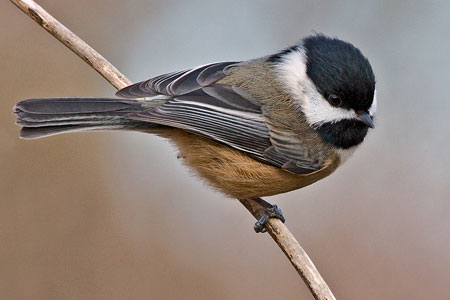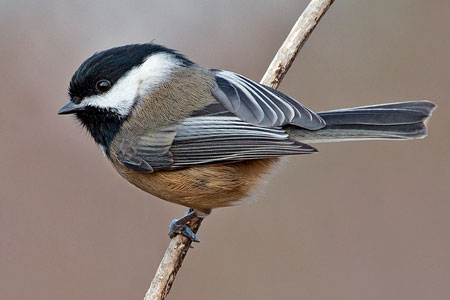
NatureMapping Animal Facts
Black-capped Chickadee
|
Black-capped Chickadee (Parus atricapillus)
Calls: The chickadee makes at least 15 different calls to communicate with its flockmates and offspring. The best known is the chickadee-dee-dee that gives the bird its name. Male chickadees also sing a short ditty of two or three whistled notes (one higher and slightly longer, followed by one or two lower, shorter ones): feee-bee or feee-bee-bee. Call: suggests name "chick-a-dee-dee." Listen to calls of this species » 
Range / Habitat: The Black-capped Chickadee can be found in deciduous and mixed deciduous/coniferous woodlands, open woods and parks, willow thickets, and cottonwood groves. They are also commonly found in fields and suburban areas. In Washington, the Black-capped Chickadee is common at lower elevations where hardwood trees occur, but very local in the Columbia Basin. In western Washington, it is found in most settled areas and wetlands with suitable hardwood vegetation. In eastern Washington, it occurs in similar habitats, but is more restricted to wetlands. Click the range map to learn more about the distribution of Black-capped Chickadee in Washington. Diet: Black-capped Chickadees eat large quantities of insect eggs, larvae and pupae (insects in the torpid stage), weevils, lice, sawflies, and other insects. They also feed on centipedes, snails, slugs, and spiders. The chickadee is one of the most important pest exterminators of the orchard or forest.  They consume some berries and seeds, especially in the winter when insects become scarce. They are commonly seen at bird feeders.
They consume some berries and seeds, especially in the winter when insects become scarce. They are commonly seen at bird feeders.
Behavior: The Black-Capped Chickadee hides seeds and other food items for later recovery during colder weather. Each item is placed in a different spot and a bird can remember the hiding places a month after caching the food. Chickadees live in small groups and establish a dominance hierarchy, or "pecking order." Each bird is known to the other according to rank which is set by its degree of aggressiveness. Accordingly, all the birds in the flock are subordinate to the most aggressive bird; and the lowest ranking bird is subordinate to all the others. Nesting: These small birds build nests in holes, typically in dead trees or rotten branches. The nest is made of coarse materials such as moss and is lined with soft material like fur. The females lays 6-8 white eggs - marked with fine spots of reddish brown. She incubates the eggs for 12-13 days, until they hatch. The young are naked and helpless with small patches of down. Chicks grow quickly and fledge in 14-18 days.
Did you know?

Black-capped Chickadee More information:
|
